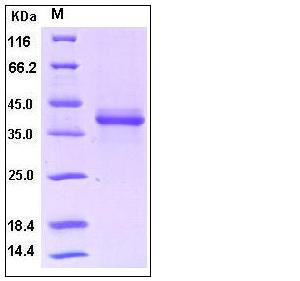Human S100A1 Protein (Fc Tag)
S100,S100-alpha,S100A
- 100ug (NPP4227) Please inquiry
| Catalog Number | P10179-H01H |
|---|---|
| Organism Species | Human |
| Host | Human Cells |
| Synonyms | S100,S100-alpha,S100A |
| Molecular Weight | The recombinant human Fc/S100A1 is a disulfide-linked homodimeric protein. The reduced monomer consists of 330 amino acids and has a predicted molecular mass of 37.1 kDa. As a result of glycosylation, the apparent molecular mass of rhFc/S100A1 monomer is approximately 40 kDa in SDS-PAGE under reducing conditions. |
| predicted N | Glu 20 |
| SDS-PAGE |  |
| Purity | > 95 % as determined by SDS-PAGE |
| Protein Construction | A DNA sequence encoding the human S100A1 (NP_006262.1) (Gly 2-Ser94) was expressed with the N-terminal fused Fc region of human IgG1. |
| Bio-activity | Measured by its ability to bind biotinylated Human Fc-S100B (cat: 10181-H01H) in functional Elisa. |
| Research Area | Neuroscience |Cell Type Marker in Neurodevelopment |Neuronal Cell Markers |Synapse & Synaptic Proteins |Calcium Signaling |Calcium Binding Protein | |
| Formulation | Lyophilized from sterile 100mM Glycine, 10mM NaCl, 50mM Tris, pH 7.5 1. Normally 5 % - 8 % trehalose, mannitol and 0.01% Tween80 are added as protectants before lyophilization. Specific concentrations are included in the hardcopy of COA. |
| Background | S100A1 is a Ca2+binding protein of the EF-hand type that belongs to the S100 protein family. S100 proteins consisting of at least 19 members exist as dimers in the cytoplasm and/or nucleus of a wide range of cells, and are involved in the regulation of a number of cellular processes such as cell-cycle progression and cell differentiation.This protein has been shown to function in the processes including stimulation of Ca2+-induced Ca2+ release, inhibition of microtubule assembly, and inhibition of PKC-mediated phosphorylation.. Phosphoglucomutase is a target protein whose activity is antagonistically regulated by S100A1, and recently, S100A1 is also identified as a potent molecular chaperone and a new member of the Hsp70/Hsp90 multichaperone complex. S100A1 displays a tissue-specific expression pattern with highest levels in myocardium and is considered to be an important regulator of cardiac contractility. Accordingly, reduced expression or mutations of S100A1 gene have been implicated in cardiomyopathies. |
| Reference |
